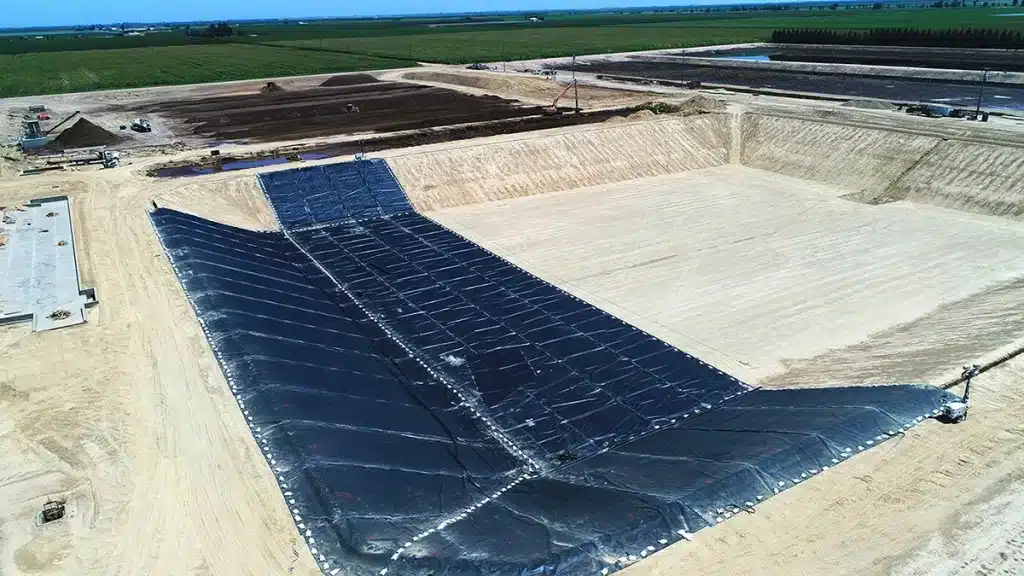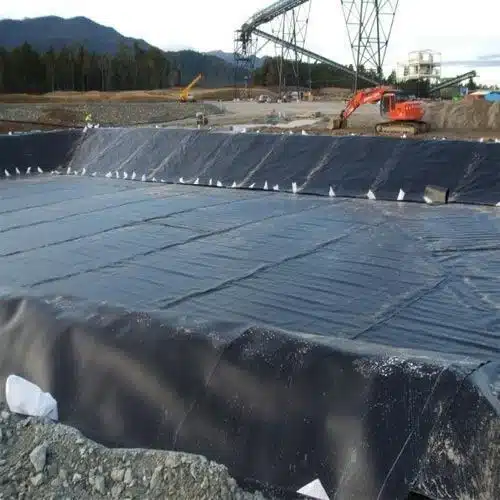+86-159 9860 6917
info@geofantex.com
geofantex@gmail.com
+86-400-8266163-44899
HDPE geomembrane pond liners stand as a fundamental safeguard in diverse environmental and industrial applications. Crafted from high-density polyethylene, these impermeable liners offer a sturdy and dependable solution to protect against leaks in ponds, landfills, and industrial reservoirs. Their remarkable resistance to chemical degradation, combined with puncture and tear resilience, ensures the longevity of containment systems. Whether your project involves lining a pond, safeguarding a landfill, or fortifying a reservoir, HDPE geomembrane pond liners provide an effective barrier that not only prevents harmful seepage but also contributes to preserving the surrounding ecosystem. Invest in the reliability and sustainability of your environmental projects with HDPE geomembrane pond liners.

What is an HDPE Geomembrane Pond Liner?
Key aspects and benefits:
- Composition and Properties: Made from HDPE, these liners offer high tensile strength, chemical and UV resistance, impermeability, and flexibility to accommodate ground movement.
- Environmental Applications: Used in ponds, irrigation canals, reservoirs, landfills, and wastewater treatment systems to prevent seepage and contamination.
- Agricultural and Industrial Uses: Ideal for fish ponds, irrigation ponds, and tailing ponds in mining operations, reducing water loss and controlling contamination.
- Durability and Lifespan: Designed to last over 30 years when properly installed, providing long-term containment solutions.
- Environmental Impact: HDPE liners prevent soil and water contamination and are recyclable, supporting sustainable construction practices.
- Installation: Involves site preparation, subgrade evaluation, panel seaming/welding, and quality control to ensure leak-proof performance.
What are the Key Applications of HDPE Geomembrane Pond Liners?
HDPE geomembrane pond liners are highly versatile and used across various industries for their durability and impermeability. Here’s a breakdown of their key applications:
- Environmental Protection: HDPE geomembranes are extensively used in protecting natural resources by preventing the leakage of pollutants into soil or groundwater. In landfills, they act as liners to contain hazardous waste, preventing contamination of the environment.
Example: A major landfill in California used HDPE geomembranes to line its waste containment area, successfully preventing contamination of the surrounding environment. - Water Management: These liners are widely used in water containment systems, such as reservoirs, ponds, and canals, to prevent water loss due to seepage. They provide an efficient solution for conserving water in arid regions.
Example: A large irrigation pond in Arizona used HDPE liners to reduce water loss, improving water efficiency for local agriculture. - Agriculture: In agricultural applications, HDPE liners are used in fish ponds, irrigation ponds, and containment for agricultural runoff, ensuring minimal water loss and controlling contamination.
Example: An agricultural operation in Texas implemented HDPE geomembrane liners for aquaculture ponds to reduce water waste and control algae growth. - Waste Containment: HDPE geomembranes are essential in creating secure containment areas for hazardous or non-hazardous waste, including in the construction of containment ponds for wastewater treatment.
Example: A wastewater treatment facility in the UK employed HDPE geomembranes in their lagoon system to contain treated water, ensuring compliance with environmental standards.
These liners are indispensable in ensuring safety, sustainability, and environmental protection in these industries.
What Advantages Do HDPE Geomembrane Pond Liners Offer?
HDPE geomembrane pond liners provide multiple benefits that make them a preferred choice for environmental, agricultural, and industrial applications:
- High Chemical Resistance: Withstand exposure to acids, bases, salts, and other chemicals without degradation.
- Puncture and Tear Resistance: Durable enough to resist mechanical damage during installation and operation.
- Long Lifespan: Designed to last over 30 years when properly installed, ensuring long-term containment.
- Impermeability: Prevent leakage of water and contaminants, protecting soil and groundwater.
- Low Maintenance: Minimal upkeep is required, reducing overall operational costs.
- Environmental Sustainability: Recyclable material and effective containment help reduce environmental impact.
These advantages make HDPE geomembrane pond liners a reliable, cost-effective, and environmentally responsible solution for water and waste containment projects.
How are HDPE Geomembrane Pond Liners Installed?
The installation of HDPE geomembrane pond liners typically involves site preparation, subgrade evaluation, seaming and welding of liner panels, and quality control measures to ensure a secure and leak-proof barrier. Proper installation is crucial to the liner’s effectiveness.
What is the Environmental Impact of HDPE Geomembrane Pond Liners?
HDPE geomembrane pond liners have a relatively low environmental impact, thanks to their durability and resistance to chemical degradation. They help prevent soil and water contamination by providing an impermeable barrier, reducing the risk of harmful leaks, and protecting the surrounding ecosystem.

In conclusion, HDPE geomembrane pond liners are a versatile and effective solution for a range of containment and environmental protection needs. Their impermeable nature, durability, and low environmental impact make them a popular choice in various industries, safeguarding against leaks and potential hazards. Whether you’re looking to line a pond, landfill, or reservoir, HDPE geomembrane pond liners offer reliable and long-lasting protection.



Get Free Sample
We’ll respond as soon as possible(within 12 hours)





















